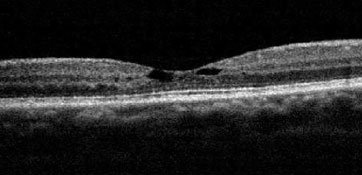BLOG: Macular issues can reduce acuity in cataract patients
Our last blog discussed how cataract surgery has the potential to influence other ocular problems, and we looked at corneal sources of vision loss that need to be disentangled from cataract-induced vision loss, including other vision-limiting pathology, corneal irregularity limiting refractive outcomes and dry eye.
This second entry in the series will look primarily at macular sources of reduced acuity that are frequently seen in a cataract patient and occur much more frequently than subtle corneal vision loss.
Epiretinal membrane
In our experience, epiretinal membrane (ERM) is the most frequently undiagnosed noncataract source of vision loss in patients considering cataract surgery, primarily due to the sheer volume of patients with the pathology. In one meta-analysis (Xiao et al.), ERMs were present in an older population in more than 14% of patients from the Americas, with more severe disease present in about 3% of patients.
The fact that ERMs sometimes evade detection prior to surgical referral probably relates to not dilating patients. Subtle ERMs can be near impossible to see in a nondilated exam, and ultra-wide field imaging can fail to capture them as well. Even in a best case with a dilated exam, subtle ERMs can be difficult to visualize through the cataract and take practice to pick up on. The biggest clue, again, is an exam where vision is not in line with cataract. Also, most eyes with ERM have a posterior vitreous detachment. If you see a Weis ring, make sure you carefully attend to the macula.
In addition to the importance of alerting patients to the presence of a visually significant ERM that may limit postoperative acuity, these patients also have a greater risk for complication. Incidence of postoperative cystoid macular edema is higher in eyes with this pathology. For this reason, topical NSAIDs should be added to the postoperative drops and possibly as a preoperative regimen.
In cases where the ERM is clearly the primary source of vision loss, a retina consult may precede the cataract evaluation. Although many retinologists will prefer the cataract be removed prior to vitreoretinal surgery, having care established with the appropriate providers is important for expectations and for streamlining care, and some surgeons will be able to treat both the cataract and macular pathology in one operation.
Macular telangiectasia/Juxtafoveal retinal telangiectasia
Macular telangiectasia (mac tel) is a pathology that has been identified for decades but is becoming much more widely recognized since the advent of retinal OCT imaging, which has made its diagnoses widely achievable. This is an idiopathic condition that results in the development of clefts or cavitations in the fovea that limit visual acuity.
While there are subtle slit lamp clues that you are dealing with mac tel (paramacular micro-telangiectasias, tortuosity of the paramacular capillaries), many cases don’t have any clinically diagnostic findings, and the condition essentially requires an OCT to confidently diagnose. This is another example illustrating how important it is to make sure the extent of cataract is in line with the extent of vision loss when determining the source of a patient’s vision loss.

In our experience, mac tel is probably the most common comorbidity in a patient whose is vision is plainly reduced beyond what the cataract indicates and who has a totally normal (beyond the cataract) clinical exam. There is no effective treatment for mac tel, so retinal clearance isn’t specifically necessary, but plugging the patient in with a retinal clinic – either pre- or postoperatively – for monitoring purposes is a good idea. At minimum, the patient should be educated about the condition and its permanent impact on vision.
AMD
When we see patients for cataract evaluations with AMD, the macular disease is almost always diagnosed and monitored by the primary optometrist, so under-diagnosis heading into cataract surgery isn’t really an issue. Further, all eye doctors are aware that any patient with exudative AMD needs to be stabilized prior to cataract surgery.
The question we run into frequently in this patient population has less to do with diagnostics/treatment and more to do with the surgery’s impact on AMD progression. Fortunately, current research seems to indicate that modern cataract surgery has little to no impact on the course of AMD and should not be delayed for fear of worsening the macular disease. In the event the patient is receiving treatment for wet AMD, it is important to communicate with the retinologist on their preference regarding timing of cataract surgery relative to their injection cycle.
Diabetic retinopathy
Diabetics are at an increased risk of developing macular edema after cataract surgery. Because of this, diabetics should probably use an NSAID postoperatively, especially if they have any retinopathy. Further, any diabetic with pre-existing macular edema, whether it’s defined as clinically significant macular edema (CSME) or non-CSME diabetic macular edema (no matter how minor), needs a pre-surgery retinal consult to determine whether pre-treatment with intravitreal medication is appropriate. For diabetics with normal compact foveas (on OCT) but severe diabetic retinopathy, we prefer that they receive fluorescein imaging and retinal clearance prior to cataract surgery.
Unfortunately, macular pathology can occasionally be difficult to detect on clinical exam and is made more difficult by having to view through a cataract. Therefore, vision loss that is disproportionate to the cataract with an otherwise normal clinical exam should lead to a macular OCT, which will often identify visually significant macular disease.
If you don’t have access to an OCT, counseling the patient about this discrepancy can help avoid patient disappointment if macular pathology is identified at the surgery center. Identification of the macular pathology is important not just for counseling purposes, but because in some instances the cataract surgery may impact the macular disease and occasionally may require retinal clearance for surgery.
The third and final article in our this will cover some other instances where cataract surgery can exacerbate already-existing pathology.
Reference:
Xiao W, et al. BMJ Open; 2017;7e014644.doi:10.1136/bmjopen-2016-014644.
